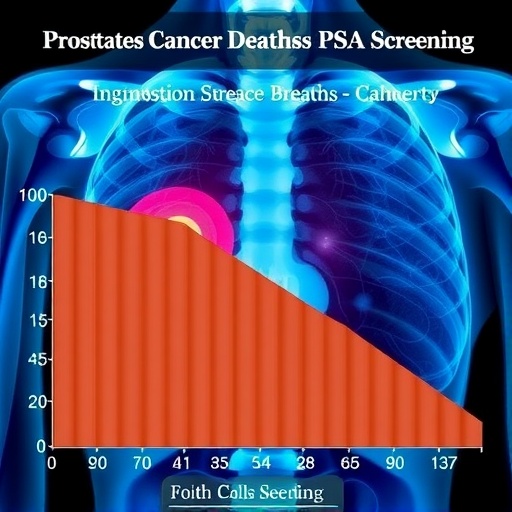A groundbreaking European study has delivered compelling evidence that prostate-specific antigen (PSA) screening can lead to a sustained reduction in mortality from prostate cancer over an extended period. This landmark research, emerging from the European Randomized Study of Screening for Prostate Cancer (ERSPC), now boasts a 23-year follow-up, providing unprecedented insight into the long-term effectiveness and pitfalls of PSA testing. Despite this positive impact on survival, the study simultaneously underscores a crucial concern that has long shadowed PSA screening — overdiagnosis of indolent prostate cancers that would not otherwise have affected patients’ lifespans.
The multicenter ERSPC, which began in the mid-1990s, is the largest and most rigorous investigation into the consequences of widespread PSA screening across Europe. The study assembled more than 160,000 men from eight countries, with nearly half recruited from Finland. These long-term data indicate a statistically significant 13% relative reduction in deaths from prostate cancer attributable to PSA screening. This translates to a number needed to screen (NNS) of 456 to prevent a single prostate cancer death—meaning inviting 456 men to PSA testing saves one life from this disease by reducing fatal outcomes.
Professor Anssi Auvinen, a leading epidemiologist at Tampere University, who played a pivotal role in coordinating the Finnish arm of the trial, explains the nuanced findings. “Although the beneficial mortality impact of PSA screening is undeniable, it diminishes over time once organized screening is halted, basically disappearing within nine years,” he notes. This observation challenges assumptions that single or short-term screening rounds provide lasting protection, emphasizing the need for sustained, repeat interventions or alternative risk-stratified approaches.
While the study’s overarching message affirms the life-saving potential of PSA screening, it also vividly illustrates the intrinsic limitations and ethical dilemmas that practitioners face. Chief among these is overdiagnosis, wherein clinically insignificant prostate cancers—tumors so slow-growing they would cause no symptoms or harm during a patient’s expected lifetime—are detected and treated unnecessarily. The consequences of overdiagnosis are far from trivial; they burden patients with treatments that confer no survival advantage but can generate adverse effects such as urinary incontinence, erectile dysfunction, and a reduced quality of life.
To contextualize the screening outcomes further, the ERSPC findings indicate that at the initial screening, 16% of men exhibited elevated PSA levels; however, only 24% of those men were confirmed to have prostate cancer following biopsy. This striking disparity suggests a considerable proportion of diagnostic interventions might be unnecessary, inflicting physical and emotional harms without clear benefits. Such data sharpen the focus on optimizing the screening paradigm to enhance specificity and improve patient selection criteria.
Crucially, the PSA value itself remains a powerful predictive biomarker, not only for the presence of prostate cancer but also for forecasting the risk of prostate cancer mortality. Leveraging this predictive utility, researchers are now advocating for ‘risk-based screening’ models. These involve tailored screening intervals and thresholds based on individual risk profiles rather than applying uniform screening criteria to all men. This nuanced approach aims to maximize detection of aggressive, clinically significant cancers, while minimizing overdiagnosis of indolent cases.
Significant advancements since the ERSPC’s inception—including the integration of multiparametric magnetic resonance imaging (MRI)—have already demonstrated potential to refine screening accuracy further. MRI enables better visualization of prostate anatomy, guiding biopsy decisions and reducing unnecessary procedures. Coupled with risk calculators that integrate PSA levels along with other patient-specific factors such as age, family history, and genetic markers, risk-based screening promises a new era where the trade-offs between harm and benefit are better balanced.
The ERSPC notably included scientific and clinical contributions from renowned institutions across Europe. Finnish collaborators, including Tampere University and University of Helsinki alongside their associated hospitals and the Finnish Cancer Registry, provided key data for this extensive trial. Coordinated by the Erasmus University Medical Centre in Rotterdam, the ERSPC represents a monumental collaborative effort in cancer epidemiology and public health intervention research.
Despite prostate cancer’s status as the most common malignancy among men worldwide and its significant mortality impact—ranking second in Finland and third across Europe—no national PSA screening program currently exists in Finland. The study’s findings have rekindled healthcare policy discussions regarding whether implementing such programs could be justified. The complex balance between reduction in cancer deaths and risk of overdiagnosis and overtreatment is central to these debates.
Many experts emphasize the need for continued research into personalizing screen-and-treat strategies based on evolving biological understanding of prostate cancer. With further innovation in biomarkers, imaging, and genomics, the goal is to create screening paradigms that deliver mortality benefit while preserving patients’ quality of life.
Published in the prestigious New England Journal of Medicine on October 29, 2025, this study sets a new benchmark in our understanding of prostate cancer screening dynamics over more than two decades. The long-term follow-up delivers critical evidence to guide clinicians, policymakers, and patients seeking clarity amid ongoing controversies about whom to screen, when, and how often.
In summary, the ERSPC study reinforces that PSA screening maintains an important role in preventing deaths from prostate cancer but also highlights the significant challenge of overdiagnosis inherent to current methodologies. Future screening programs will likely evolve toward risk-adapted protocols that integrate diagnostic imaging and molecular profiling to maximize benefits while minimizing harms. As prostate cancer remains a leading cause of male cancer mortality, these findings will resonate deeply across medical communities and shape cancer control strategies well into the future.
Subject of Research: Long-term impact of prostate-specific antigen (PSA) screening on prostate cancer mortality and overdiagnosis
Article Title: European Study of Prostate Cancer Screening — 23-Year Follow-up
News Publication Date: 29 October 2025
Web References:
https://www.nejm.org/doi/full/10.1056/NEJMoa2503223
https://www.tuni.fi/en/research/finnish-randomized-study-screening-prostate-cancer-finrspc
References:
New England Journal of Medicine, DOI: 10.1056/NEJMoa2503223
Image Credits: Not provided
Keywords: Prostate cancer, PSA screening, overdiagnosis, mortality reduction, risk-based screening, magnetic resonance imaging, ERSPC, prostate-specific antigen, long-term follow-up, cancer epidemiology
Tags: epidemiology of prostate cancerEuropean Randomized Study of Screening for Prostate Cancerindolent prostate cancerslong-term follow-up prostate cancer studymen’s health and cancer preventionmulticenter prostate cancer researchnumber needed to screen for prostate canceroverdiagnosis in prostate cancerProstate cancer mortality reductionprostate cancer screening guidelinesPSA screening effectivenessstatistical significance in cancer studies





